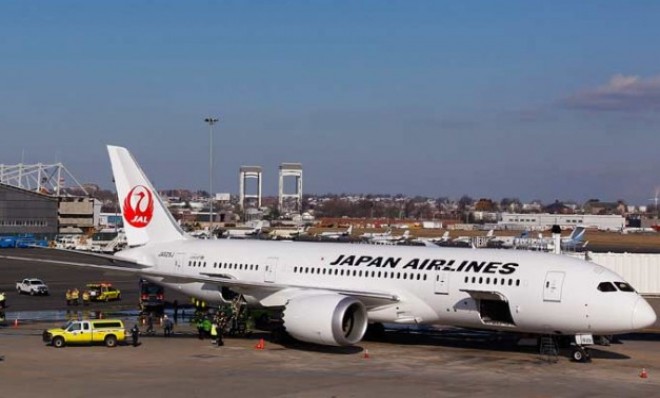Is Boeing's 787 Dreamliner in trouble?
The future of aircraft has run into some ominous problems


After years of delays, Boeing's 787 Dreamliner was rolled out in late 2011 to generally rapturous reviews. The Dreamliner is not only the world's first passenger plane to be composed largely of lightweight carbon composite, which helps save fuel and cuts down on energy costs, it also boasts higher ceilings, larger windows, bigger overhead cabins, and — cue light bursting through clouds, angels singing — touch-free faucets and toilets in the bathroom.
But the lofty expectations for the Dreamliner returned to earth this week, with a series of mishaps that have called the aircraft's safety into question. On Monday, an electrical fire broke out in a Japan Airlines Dreamliner that had arrived in Boston from Tokyo. The next day, another JAL Dreamliner returned to its gate in Boston after it suffered a large fuel leak. And today, an All Nippon Airways Dreamliner in Japan canceled a domestic flight after its computer indicated — mistakenly as it turns out — a problem with the plane's brakes.
Airline executives, many of whom have spent a pretty penny investing in Dreamliners, claim that the problems are minor. "Of course there will be teething problems from time to time," said Akbar al-Baker, the CEO of Qatar Airways. "It doesn't mean we are going to cancel our orders. It's a revolutionary airplane." Qatar Airways has bought 30 Dreamliners, with the option for 30 more; the planes retail for about $200 million apiece.
The Week
Escape your echo chamber. Get the facts behind the news, plus analysis from multiple perspectives.

Sign up for The Week's Free Newsletters
From our morning news briefing to a weekly Good News Newsletter, get the best of The Week delivered directly to your inbox.
From our morning news briefing to a weekly Good News Newsletter, get the best of The Week delivered directly to your inbox.
Some airline analysts agree. "None of this is a showstopper, and none of this should signal this product is fundamentally flawed," Richard Aboulafia, an aerospace analyst, told The New York Times. However, the Federal Aviation Administration in December had warned of leaks and fires in the pricey aircraft, and ordered inspections. In addition, Dreamliners were involved in three malfunctions shortly after their debut, including two engine failures in ground tests.
Even if the planes are sound, Boeing is taking a public relations hit. The company's stock price fell by nearly five percent on Monday and Tuesday, before bouncing back on Wednesday. Furthermore, the Dreamliner's problems have raised questions about Boeing's eagerness to get the plane off the ground, as it were. "While they delivered a large and unexpected number of 787s last year, it's possible that they should have instead focused on identifying glitches and flaws," Aboulafia told Reuters, "rather than pushing ahead with volume production."
A lot is on the line for Boeing, which is virtually betting its entire future on the Dreamliner. Boeing hopes to sell 5,000 of the planes over the next 20 years, and industry observers say it could take years before the company begins seeing a profit on an investment whose start-up costs have only ballooned. If more mishaps or more serious issues occur, the company could find itself in a tight spot.
A free daily email with the biggest news stories of the day – and the best features from TheWeek.com
Ryu Spaeth is deputy editor at TheWeek.com. Follow him on Twitter.
-
 What’s the best way to use your year-end bonus?
What’s the best way to use your year-end bonus?the explainer Pay down debt, add it to an emergency fund or put it toward retirement
-
 10 concert tours to see this winter
10 concert tours to see this winterThe Week Recommends Keep cozy this winter with a series of concerts from big-name artists
-
 What are portable mortgages and how do they work?
What are portable mortgages and how do they work?the explainer Homeowners can transfer their old rates to a new property in the UK and Canada. The Trump administration is considering making it possible in the US.